
NGC 4725 is an intermediate barred spiral galaxy with a prominent ring structure, located in the northern constellation of Coma Berenices near the north galactic pole. It was discovered by German-born British astronomer William Herschel on April 6, 1785. The galaxy lies at a distance of approximately 40 megalight-years from the Milky Way. NGC 4725 is the brightest member of the Coma I Group of the Coma-Sculptor Cloud, although it is relatively isolated from the other members of this group. This galaxy is strongly disturbed and is interacting with neighboring spiral galaxy NGC 4747, with its spiral arms showing indications of warping. The pair have an angular separation of 24′, which corresponds to a projected linear separation of 370 kly. A tidal plume extends from NGC 4747 toward NGC 4725.

NGC 1818 is a young globular cluster in the north-west part of the Large Magellanic Cloud, about 3.2 kpc from the center. It was discovered by Scottish astronomer James Dunlop in 1826, and has since been well studied.

NGC 1808 is a barred spiral galaxy located in the southern constellation of Columba, about two degrees to the south and east of Gamma Caeli. It was discovered on 10 May 1826 by Scottish astronomer James Dunlop, who described it as a "faint nebula". The galaxy is a member of the NGC 1808 group, which is part of the larger Dorado Group.
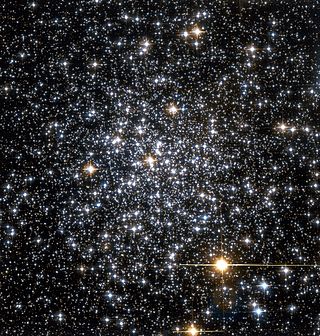
NGC 6352 is a globular cluster of stars in the southern constellation of Ara, located approximately 18.3 kly from the Sun. It was discovered by Scottish astronomer James Dunlop on May 14, 1826. The cluster has a Shapley–Sawyer Concentration Class of XI:. A telescope with a 15 cm (5.9 in) aperture is required to resolve the stars within this loose cluster.

NGC 128 is a lenticular galaxy in the constellation Pisces. It is approximately 190 million light-years from the Sun and has a diameter of about 165,000 light-years.

NGC 171 is a barred spiral galaxy with an apparent magnitude of 12, located around 200 million light-years away in the constellation Cetus. The galaxy has two main medium-wound arms, with a few minor arms, and a fairly bright nucleus and bulge. It was discovered on 20 October 1784 by William Herschel. It is also known as NGC 175.
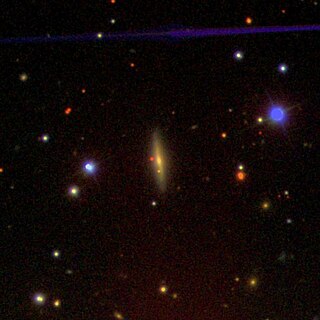
NGC 184 is a spiral galaxy located in the constellation Andromeda. It was discovered on October 6, 1883, by Édouard Stephan.

NGC 213 is a barred spiral galaxy located in the constellation Pisces. It was discovered on October 14, 1784, by William Herschel.

NGC 267 is an open cluster in the Small Magellanic Cloud. It is located in the constellation Tucana. It was discovered on October 4, 1836, by John Herschel.

NGC 269 is an open cluster in the Small Magellanic Cloud. It is located in the constellation Tucana. It was discovered on November 5, 1836 by John Herschel.

NGC 276 is a barred spiral galaxy located approximately 626 million light-years from the Solar System in the constellation Cetus. It was discovered in 1886 by Frank Muller and was later also observed by DeLisle Stewart.
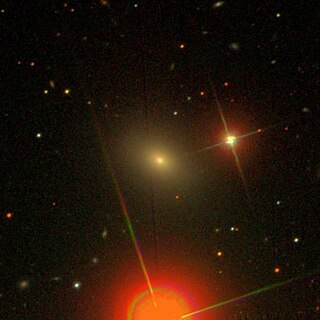
NGC 282 is an elliptical galaxy in the constellation Pisces. It was discovered on October 13, 1879 by Édouard Stephan.
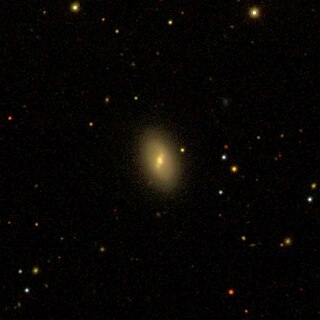
NGC 287 is a lenticular galaxy in the constellation Pisces. It was discovered on November 22, 1827, by John Herschel.

NGC 304 is a lenticular galaxy in the constellation Andromeda. It was discovered on October 23, 1878, by Édouard Stephan.

NGC 315 is an elliptical galaxy in the constellation Pisces. Its velocity with respect to the cosmic microwave background is 4635 ± 22 km/s, which corresponds to a Hubble distance of 223.0 ± 15.7 Mly (68.36 ± 4.80 Mpc). In addition, eight non-redshift measurements give a distance of 208.58 ± 22.28 Mly (63.950 ± 6.830 Mpc). It was discovered by German-British astronomer William Herschel on September 11, 1784.
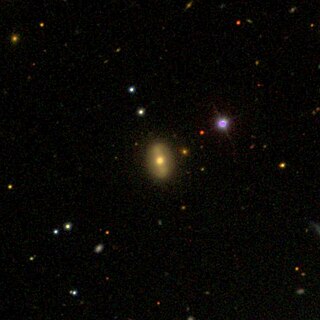
NGC 318 is a lenticular galaxy in the constellation Pisces. It was discovered on November 29, 1850 by Bindon Stoney.

NGC 1279 is a lenticular galaxy estimated to be 324 million light-years away from the Milky Way in the constellation Perseus. It has diameter of about 110,000 ly, and is a member of the Perseus Cluster.

NGC 2280 is a spiral galaxy located in the constellation Canis Major. It is located at a distance of about 75 million light years from Earth, which, given its apparent dimensions, means that NGC 2280 is about 135,000 light years across. It was discovered by John Herschel on February 1, 1835.

NGC 543 is an elliptical galaxy located around 324 million light-years away in the constellation Cetus. NGC 543 was discovered on October 31st, 1864 by Heinrich Louis d'Arrest. It is not known to have much star formation, and it is a member of the galaxy cluster Abell 194.

NGC 2293 is a lenticular galaxy located in the constellation Canis Major. It is located at a distance of circa 100 million light years from Earth, which, given its apparent dimensions, means that NGC 2293 is about 160,000 light years across. It was discovered by John Herschel on January 20, 1835. NGC 2293 forms a pair with NGC 2292 and has an HI ring that surrounds both galaxies.




















